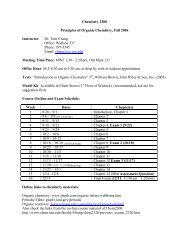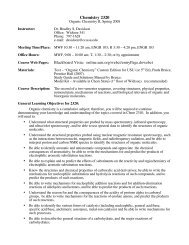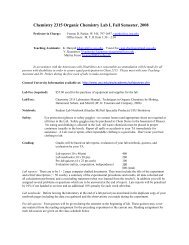1 Chapter 14: NMR Spectroscopy Learning Objectives: 1. Know how ...
1 Chapter 14: NMR Spectroscopy Learning Objectives: 1. Know how ...
1 Chapter 14: NMR Spectroscopy Learning Objectives: 1. Know how ...
You also want an ePaper? Increase the reach of your titles
YUMPU automatically turns print PDFs into web optimized ePapers that Google loves.
<strong>Chapter</strong> <strong>14</strong>: <strong>NMR</strong> <strong>Spectroscopy</strong><br />
<strong>Learning</strong> <strong>Objectives</strong>:<br />
<strong>1.</strong> <strong>Know</strong> <strong>how</strong> nuclear spins are affected by a magnetic field, and be able to explain<br />
what happens when radiofrequency radiation is absorbed.<br />
2. Be able to predict the number of proton and carbon <strong>NMR</strong> signals expected from a<br />
compound given its structure.<br />
3. Be able to predict the splitting pattern in the proton <strong>NMR</strong> spectrum of a compound<br />
given its structure.<br />
4. With the aid of a chart of chemical shifts from 1 H and 13 C <strong>NMR</strong>, be able to assign<br />
peaks in an <strong>NMR</strong> spectrum to specific protons in a compound.<br />
5. Be able to interpret integration of <strong>NMR</strong> spectra.<br />
6. Be able to use <strong>NMR</strong> spectra to determine the structures of compounds, given other<br />
information such as a molecular formula.<br />
7. Be able to calculate coupling constants from 1 H <strong>NMR</strong> spectra, and utilize the<br />
coupling constants for determining compound structure.*<br />
8. Be able to determine the compound structure based on information generated from<br />
mass spectrometry, IR, <strong>NMR</strong>, and elemental analysis.*<br />
* Supplemental material, not included in the textbook<br />
Sections:<br />
<strong>14</strong>.1 Introduction to <strong>NMR</strong> <strong>Spectroscopy</strong><br />
<strong>14</strong>.2 Fourier Transform <strong>NMR</strong><br />
<strong>14</strong>.3 Shielding*<br />
<strong>14</strong>.4 The Number of Signals in the 1 H <strong>NMR</strong> Spectrum*<br />
<strong>14</strong>.5 The Chemical Shift*<br />
<strong>14</strong>.6 The Relative Position of 1 H <strong>NMR</strong> Signals*<br />
<strong>14</strong>.7 Characteristic Values of Chemical Shifts*<br />
<strong>14</strong>.8 Integration of <strong>NMR</strong> Signals*<br />
<strong>14</strong>.9 Diamagnetic Anisotropiy<br />
<strong>14</strong>.10 Splitting of the Signals*<br />
<strong>14</strong>.11 More Examples of 1 H <strong>NMR</strong> Spectra*<br />
<strong>14</strong>.12 Coupling Constants*<br />
<strong>14</strong>.13 Splitting Diagrams*<br />
<strong>14</strong>.<strong>14</strong> Time Dependence of <strong>NMR</strong> <strong>Spectroscopy</strong><br />
<strong>14</strong>.15 Protons Bonded to Oxygen and Nitrogen*<br />
<strong>14</strong>.16 Use of Deuterium in 1 H <strong>NMR</strong> <strong>Spectroscopy</strong> #<br />
<strong>14</strong>.17 Resolution of 1 H <strong>NMR</strong> Spectra<br />
<strong>14</strong>.18 13 C <strong>NMR</strong> <strong>Spectroscopy</strong>*<br />
<strong>14</strong>.19 DEPT 13 C <strong>NMR</strong> Spectra #<br />
<strong>14</strong>.20 Two-dimensional <strong>NMR</strong> <strong>Spectroscopy</strong> #<br />
* Sections that will be focused<br />
# Sections that will be skipped<br />
1
Recommended additional problems<br />
41 – 61, 63 – 71<br />
Class Note<br />
<strong>14</strong>.1 Introduction to <strong>NMR</strong> <strong>Spectroscopy</strong> and <strong>14</strong>.2 Fourier Transform <strong>NMR</strong><br />
Applied<br />
magneti<br />
c field<br />
cap<br />
<strong>NMR</strong> tube<br />
sample<br />
<strong>14</strong>.3 Shielding<br />
Deshielded<br />
(low electron<br />
density)<br />
Shielded (high<br />
electron<br />
density)<br />
intensity<br />
H<br />
H<br />
H<br />
downfield<br />
upfield<br />
2
<strong>14</strong>.4 The Number of Signals in the 1 H <strong>NMR</strong> Spectrum<br />
*Judge the chemically equivalent of H by the symmetry of molecule<br />
H<br />
H<br />
H<br />
H<br />
H<br />
H<br />
H<br />
Cl<br />
H<br />
Cl<br />
H<br />
H<br />
H<br />
H<br />
H<br />
H<br />
H<br />
H<br />
H<br />
H<br />
H<br />
H<br />
H<br />
H<br />
Cl<br />
H<br />
H<br />
H<br />
H<br />
H<br />
H<br />
H<br />
Cl<br />
H<br />
H<br />
H<br />
H<br />
H<br />
H<br />
H<br />
CH 3<br />
H<br />
H<br />
Br<br />
Cl<br />
H<br />
NO 2<br />
Cl<br />
H<br />
Cl<br />
Cl<br />
NO 2<br />
H<br />
H<br />
H<br />
H<br />
H<br />
H<br />
H<br />
H<br />
H<br />
H<br />
H<br />
Br<br />
H<br />
H<br />
H<br />
H<br />
H<br />
H<br />
H<br />
H<br />
H<br />
Cl<br />
H<br />
H<br />
H<br />
H<br />
H<br />
H<br />
H<br />
H<br />
3
<strong>14</strong>.5 The Chemical Shift, <strong>14</strong>.6 The Relative Position of 1 H <strong>NMR</strong> Signals, and <strong>14</strong>.9<br />
Diamagnetic Anisotropiy<br />
Internal reference compound: CHCl 3 (from CDCl 3 ) and (CH 3 ) 4 Si (TMS)<br />
*Signal of TMS = 0 ppm (CHCl3 = 7.27 ppm)<br />
*Chemical shift (δ)<br />
A. Effect from electronegativity (inductive effect)<br />
H<br />
H<br />
H<br />
Cl<br />
H<br />
Cl<br />
H<br />
H<br />
H<br />
H<br />
H<br />
H<br />
H<br />
H<br />
H<br />
H<br />
4
B. Effect from resonance<br />
O<br />
O<br />
O<br />
6.15<br />
O<br />
4.92<br />
7.63<br />
6.88<br />
H<br />
OCH 3<br />
H<br />
H<br />
OCH 3<br />
H<br />
H<br />
OCH 3<br />
H<br />
H<br />
OCH 3<br />
H<br />
7.26<br />
H<br />
H<br />
6.92<br />
H<br />
H<br />
H<br />
H<br />
H<br />
H<br />
H<br />
H<br />
H<br />
H<br />
C. Effect from structure<br />
O<br />
4.73<br />
O<br />
3.75<br />
O O<br />
3.52<br />
2.54 2.72<br />
<strong>1.</strong>85<br />
<strong>1.</strong>51<br />
5
D. Diamagnetic Anisotropiy (anisotropic effect)<br />
applied magnetic field (B o )<br />
induced magnetic field (B i )<br />
H 7.3<br />
H<br />
actual magnetic field<br />
(B o + B i )<br />
<strong>14</strong>.7 Characteristic Values of Chemical Shifts<br />
Table <strong>14</strong>.1<br />
<strong>14</strong>.8 Integration of <strong>NMR</strong> Signals<br />
* Diagnostic for 1 H <strong>NMR</strong> but less accurate for 13 C <strong>NMR</strong><br />
* Ratio rather than exact number<br />
H b<br />
Hb<br />
H b<br />
H b<br />
H<br />
Cl<br />
H<br />
H<br />
H<br />
Cl<br />
H<br />
H<br />
H<br />
H a<br />
H<br />
H H H H<br />
a H H H H<br />
H a<br />
H c<br />
H<br />
H<br />
H<br />
H<br />
O<br />
H<br />
H<br />
H H<br />
H<br />
H a<br />
I<br />
II<br />
III<br />
6
<strong>14</strong>.10 Splitting of the Signals<br />
A. Multiplicity of Signal and Relative Intensities<br />
Ratio<br />
Multiplicity<br />
1 : 1 doublet<br />
1 : 2 : 1 triplet<br />
1 : 3 : 3 : 1 quartet<br />
1 : 4 : 6 : 4 : 1 quintet<br />
1 : 5 : 10 : 10 : 5 : 1 sextet<br />
1 : 6 : 15 : 20 : 15 : 6 : 1 septet<br />
Original signal<br />
1 st splitting<br />
1 1<br />
2 nd splitting<br />
1<br />
2<br />
1<br />
3 rd splitting<br />
1<br />
3 3<br />
1<br />
4 th splitting<br />
1<br />
4 6 4<br />
1<br />
5 th splitting<br />
1<br />
5 10 10 5<br />
1<br />
6 th splitting<br />
1<br />
6<br />
15<br />
20<br />
15<br />
6<br />
1<br />
Two important criteria:<br />
* For I = 1/2<br />
* For chemically equivalent nuclei<br />
7
B. Examples<br />
H b<br />
Hb<br />
H b<br />
H b<br />
H<br />
Cl<br />
H<br />
H<br />
H<br />
Cl<br />
H<br />
H<br />
H<br />
H a<br />
H<br />
H H H H<br />
a H H H H<br />
H a<br />
H c<br />
H<br />
H<br />
H<br />
H<br />
O<br />
H<br />
H<br />
H H<br />
H<br />
H a<br />
I<br />
II<br />
III<br />
8
<strong>14</strong>.11 More Examples of 1 H <strong>NMR</strong> Spectra<br />
A. More examples<br />
H d<br />
Br<br />
H H<br />
Br<br />
H a<br />
H a<br />
H 3 C<br />
H H H H<br />
H b<br />
H b<br />
IV<br />
H<br />
H H<br />
H c<br />
H<br />
O<br />
V<br />
O H<br />
H 3 C CH 3<br />
H b<br />
H e<br />
9
B. Difference between quartet (q) and doublet of doublet (dd)<br />
Cl<br />
H<br />
Br<br />
H a<br />
H<br />
H<br />
H b<br />
Cl<br />
O<br />
H<br />
Cl<br />
H<br />
H a<br />
H b<br />
H c H c<br />
OCH 3<br />
H<br />
Br<br />
H<br />
H<br />
O<br />
H<br />
H<br />
VI<br />
VII<br />
10
<strong>14</strong>.12 Coupling Constants and <strong>14</strong>.13 Splitting Diagrams<br />
A. Table <strong>14</strong>.3 and handout<br />
B. Calculation of coupling constant (J value)<br />
2.5 mm<br />
pattern A<br />
5 mm<br />
2.5 mm<br />
pattern B<br />
5 mm<br />
400 MHz 1 H <strong>NMR</strong><br />
400 MHz 1 H <strong>NMR</strong><br />
integral ratio of peaks:<br />
1:3:3:1<br />
integral ratio of peaks:<br />
1:1:1:1<br />
3.3 ppm<br />
15 mm<br />
3.2 ppm<br />
3.3 ppm<br />
15 mm<br />
3.2 ppm<br />
11
C. Splitting diagrams and J values<br />
(1)<br />
(1) J<br />
H a H b<br />
H ab = J ac (2) J ab > J ac<br />
c<br />
(2) long range coupling (4 bonds)<br />
12
D. Structure determination and J values<br />
(1) Example 1<br />
H b<br />
H a<br />
H c<br />
COCH 3<br />
J ab = 2 Hz<br />
J ac = 15 Hz<br />
J bc = 7 Hz<br />
(2) Example 2: determination of cis and trans isomers<br />
H a<br />
H a<br />
COCH 3<br />
H 3 C H 3 C<br />
J ab = 15 Hz or 7 Hz<br />
H b<br />
trans<br />
H b<br />
cis<br />
COCH 3<br />
13
(3) Example 3: determination of the regioisomers of di-substituted benzene<br />
derivatives<br />
NH 2<br />
NH 2<br />
NH 2<br />
H<br />
Br<br />
H<br />
H<br />
H<br />
H<br />
H<br />
H<br />
H<br />
Br<br />
H<br />
H<br />
H<br />
H<br />
Br<br />
1,2-di-substituted<br />
(ortho)<br />
1,3-di-substituted<br />
(meta)<br />
1,4-di-substituted<br />
(para)<br />
<strong>14</strong>
<strong>14</strong>.15 Protons Bonded to Oxygen and Nitrogen and <strong>14</strong>.16 Use of Deuterium in 1 H <strong>NMR</strong><br />
<strong>Spectroscopy</strong><br />
<strong>14</strong>.17 Resolution of 1 H <strong>NMR</strong> Spectra<br />
1 H <strong>NMR</strong><br />
60 MHz 90 MHz 300 MHz 400 MHz 600 MHz<br />
15
<strong>14</strong>.18 13 C <strong>NMR</strong> <strong>Spectroscopy</strong><br />
A. Table <strong>14</strong>.4<br />
Chemical shift and height (intensity)<br />
B. Proton-coupled and proton-decoupled 13 C spectra<br />
16
















